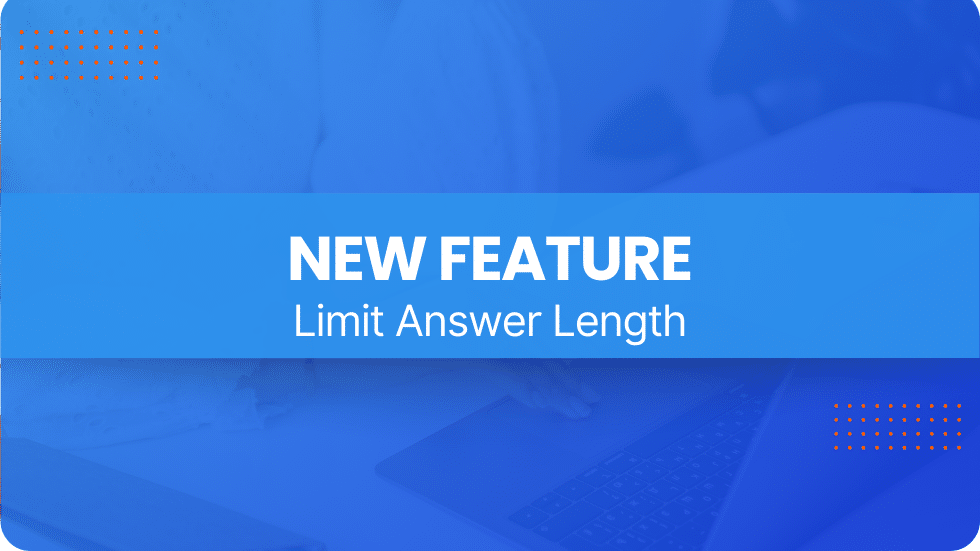Long or irrelevant responses can be a real headache. Whether you’re a coach running a self-assessment or a consultant gathering feedback, dealing with vague answers or essays that go off the rails is time-consuming and frustrating. Agolix has stepped in to solve this challenge with a new feature that allows you to set response length limits for open-ended questions. Let’s dive into how this feature can revolutionize your workflow by creating clarity, focus, and consistency.
The Problem with Open-Ended Questions
Open-ended questions are powerful tools. They allow respondents to express themselves freely, giving you qualitative insights that go far beyond numbers or scales. You can uncover details about motivations, opinions, or experiences—things that standard questions simply can’t capture.
But let’s be honest: open-ended questions aren’t always easy to work with.
The Downsides of Open-Ended Responses:
- Too Long or Off-Topic Responses: Some respondents may ramble or misunderstand the question entirely, leaving you with walls of text that miss the mark.
- Inconsistent Input: One person might respond with a short “Yes,” while another writes a novel. This inconsistency makes it difficult to compare responses.
- Time-Consuming to Analyze: Sorting through lengthy, unstructured text eats up valuable time – time you’d rather spend taking action based on the insights.
So, while open-ended questions offer depth, the lack of structure can create unnecessary friction. That’s where Agolix’s response length limits come in.
How Response Length Limits Work
Agolix has introduced a feature that allows users to set character or word limits for open-ended questions. Whether you’re working with a Narrative (text box) question or a Textfield (single-line entry), you now have full control over how detailed—or concise—responses need to be.
The Setup:
- Apply the length limit to specific open-ended questions.
- Choose the appropriate word or character count that aligns with the goals of your survey, assessment, or feedback form.
- Publish your form, knowing your respondents will stay focused while answering.
The Experience for Respondents:
This feature gently guides respondents to craft concise, relevant answers. When you set a response length limit, a hint automatically appears below the question telling the respondent how long their answer can be. When they reach that limit, they can’t input any more text. It eliminates guesswork while encouraging thoughtful and actionable responses.
Benefits:
- Clarity for Respondents: It sets clear boundaries, making it easier for people to provide quality answers.
- Efficiency for You: Short, relevant responses are quicker to review and analyze.

Practical Applications for Coaches, Consultants, and Small Businesses
So, how can you use this feature in real-life scenarios? Let’s break it down:
For Coaches:
When asking clients to outline their goals, setting a limit of 100 characters ensures responses are concise and actionable. Instead of a rambling essay, you’ll get a focused answer like, “Increase productivity by 25% this quarter.”
For Consultants:
Gathering feedback on a workshop or presentation? A 250-character limit can help keep responses relevant and to the point. This ensures you receive thoughtful input without unnecessary fluff.
For Small Businesses:
Running a customer satisfaction survey? Use a character limit for questions like, “What can we improve?” to streamline results and make data analysis faster and more effective.
This feature works across industries, allowing professionals to get the insights they need without the hassle of wading through inconsistent or excessive answers.
Best Practices for Open-Ended Questions
To maximize the impact of response length limits in Agolix, consider the following tips:
1. Combine Open-Ended Questions with Other Formats
Use open-ended questions alongside multiple-choice or scale-based questions. This gives you both structured and unstructured data for a well-rounded analysis.
2. Tailor the Limit to Your Goals
Need quick insights? Stick to shorter limits. Looking for more detailed input? Expand the character count. The key is balancing brevity and depth.
3. Use Complementary Agolix Features
Pair response length limits with other Agolix tools, like automated reporting. This helps you summarize and visualize responses quickly, saving you even more time.
4. Be Transparent
Let respondents know why you’re asking them to keep answers concise. A brief note like, “This helps us understand your goals better,” can go a long way in setting expectations.
Why This Feature Matters
Ultimately, limiting response length isn’t just about saving time—it’s about enhancing the quality of your data. By encouraging clarity and focus, you’ll gather insights that are easier to analyze and act upon. Whether you’re running a coaching program, consulting on business strategy, or conducting customer surveys, this feature can transform the way you collect and use information.
Ready to Try It?
Agolix’s response length limits are here to make your life easier. With this simple yet powerful feature, you’ll spend less time sorting through messy data and more time focusing on what really matters: delivering value to your clients, customers, or team. Ready to see the difference for yourself? Log in to Agolix today and start refining your responses for clarity, consistency, and efficiency.




